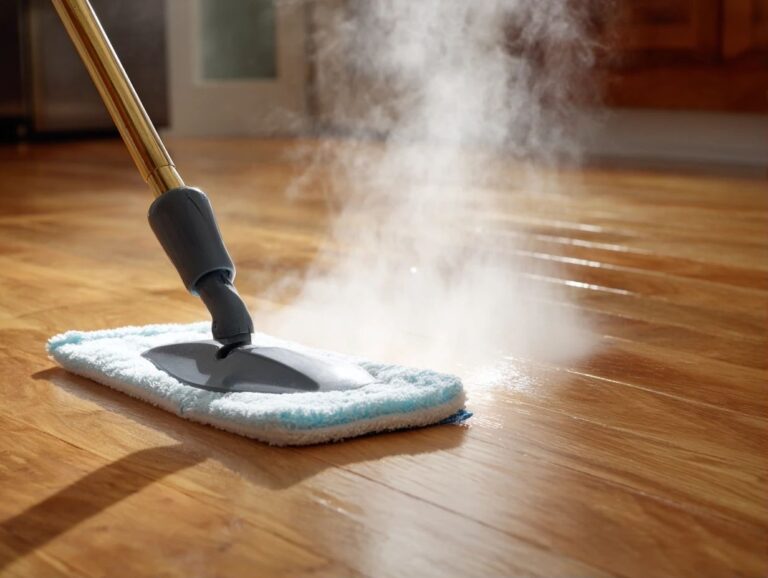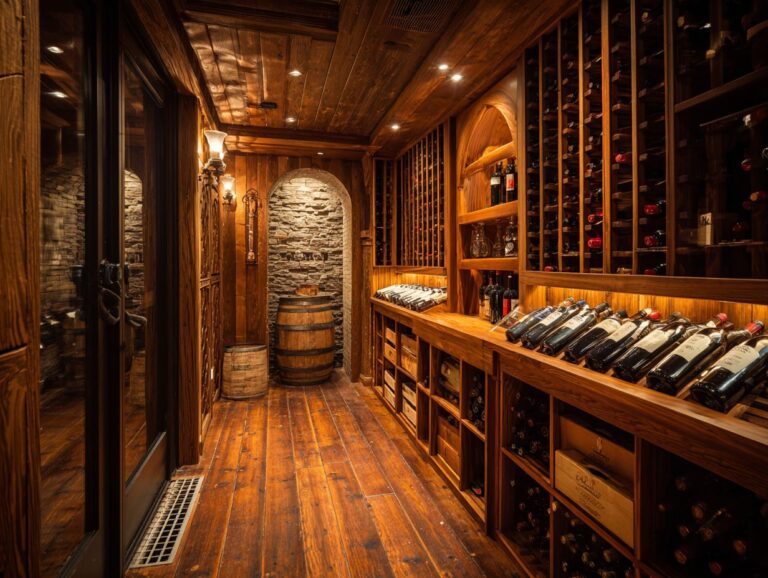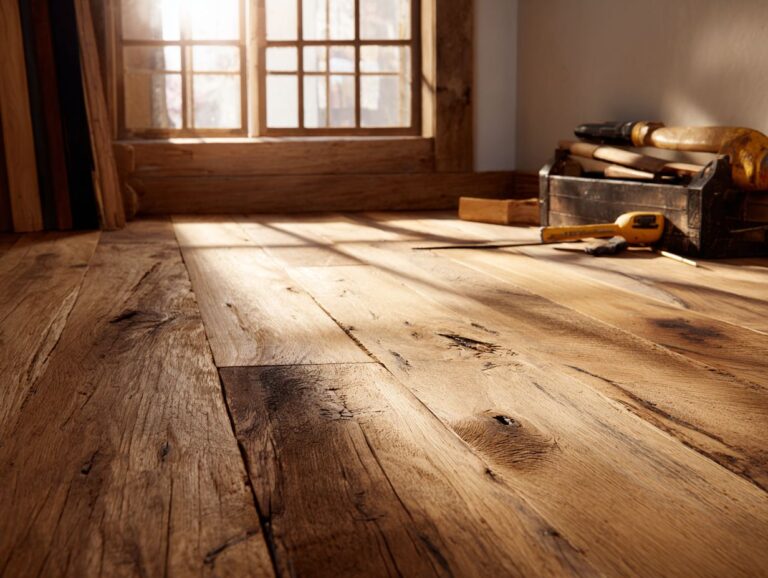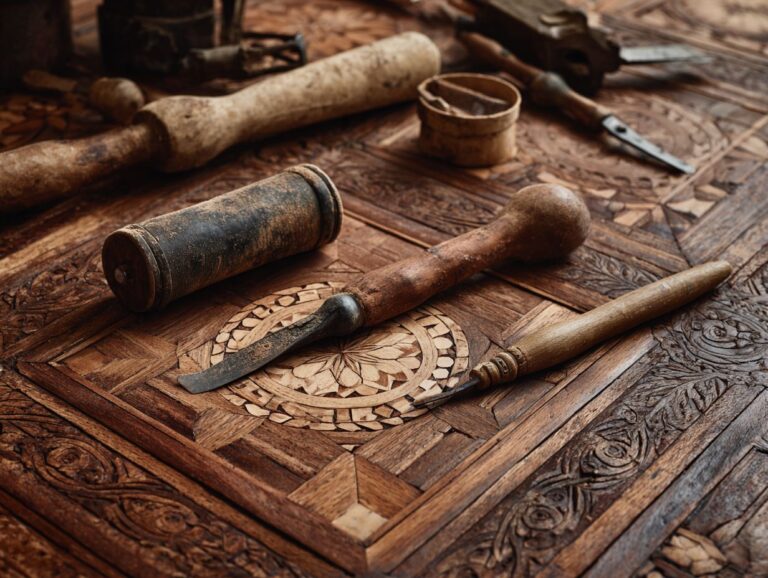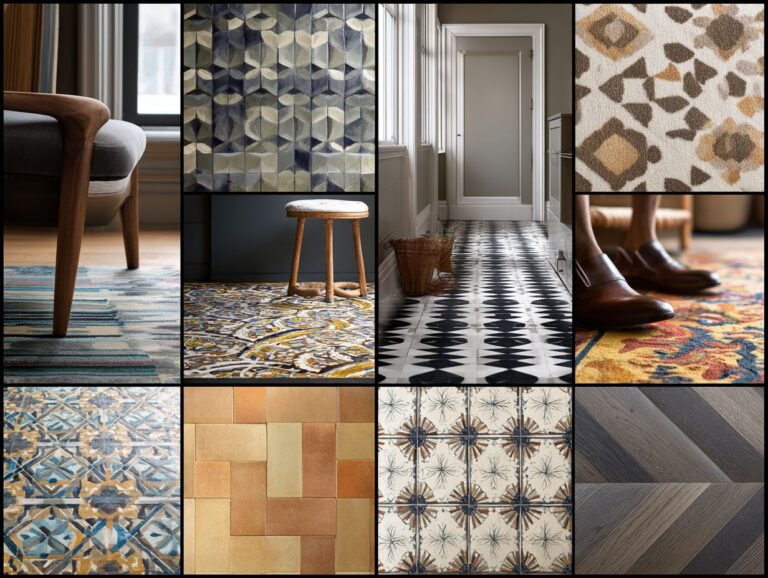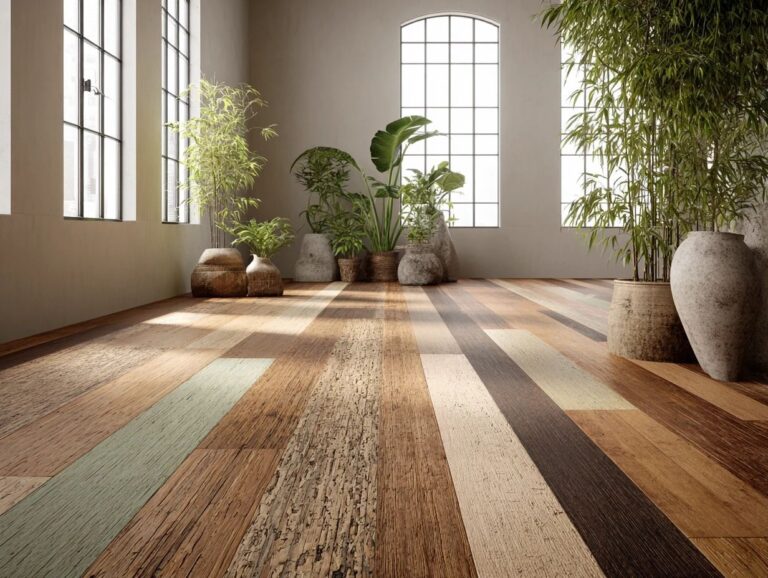Mixed-Width Flooring – Random Pattern Popularity
Learn about mixed-width flooring, a popular choice in interior design because of its interesting and varied patterns. As showcased by Gaylord Hardwood Flooring, this approach to hardwood planks creates a unique visual appeal, elevating any space. In this article, we’ll look at why random width flooring has become more popular. We’ll talk about how it looks good and works well in different styles, making it a great choice for your next home renovation.
Key Takeaways:
Contents
- The Appeal of Random Patterns
- Materials Used in Mixed-Width Flooring
- Installation Techniques
- Maintenance and Care
- Market Trends and Popularity
- Mixed-Width Hardwood Flooring Popularity
- Frequently Asked Questions
- What is mixed-width flooring and why is it becoming popular?
- Is there a specific pattern for mixed-width flooring or can it be random?
- What types of materials can be used for mixed-width flooring?
- Can mixed-width flooring be used in any room of the house?
- Are there any benefits to choosing a random pattern for mixed-width flooring?
- What are some important factors to consider when installing mixed-width flooring?
Definition and Overview

Mixed-width flooring means using planks of different sizes in one installation to improve the look and feel of a room.
This method is different from standard uniform-width flooring, which can look more stiff and less lively. For example, brands like Carlisle Wide Plank Floors offer custom mixed-width options, allowing widths ranging from 3 to 10 inches.
This variance creates a rustic, yet sophisticated look, perfect for homes desiring a unique aesthetic. For installation, try using a random layout pattern to make it look more visually appealing.
Make sure the mix fits well with your interior design, whether it’s modern or country-themed.
Historical Context
The use of mixed-width planks dates back centuries, reflecting a rustic aesthetic that celebrates the character of natural hardwood species like hickory and oak.
This flooring style creates visual appeal with different widths and brings out the distinct grain patterns of each wood type.
For example, hickory, known for its striking contrasts and durability, complements wider boards, while the classic charm of oak often shines in narrower planks.
When sourcing mixed-width flooring, consider companies like Bruce Hardwood and Hartco, which offer a range of options that pay homage to this traditional look.
Putting in flooring with different widths can make rooms look bigger and more welcoming.
The Appeal of Random Patterns
Random patterns in flooring with varying widths offer a unique design feature and help create a unified appearance.
Aesthetic Benefits
Using random patterns in flooring gives rooms a visually appealing look, creating a warm and welcoming atmosphere.
For instance, consider a living room featuring herringbone hardwood alongside a rug with a playful geometric pattern. This combination gives depth and creates a cozy atmosphere.
Sites like Pinterest and Houzz display different completed projects, where designers use random patterns to create particular styles-such as rustic, modern, or eclectic.
Mixing various textures and colors in unexpected ways makes each piece noticeable while still maintaining harmony. This changes plain areas into places that look interesting and promote relaxation and imagination.
Design Versatility
Mixed-width flooring works with various interior styles, such as rustic and modern, and is often chosen by interior designers.
For example, in a farmhouse, using reclaimed wood with different widths adds to the rustic appeal. In a modern home, smooth, wide planks can give a simple and striking appearance.
Successful installations can be seen in a boutique hotel featuring a mix of light and dark woods to establish warmth, and a trendy caf utilizing narrow strips to create a cozy atmosphere.
By selecting the right finish and color palette, mixed-width flooring can seamlessly blend into any design narrative.
Texture and Depth
Using different plank sizes makes rooms look interesting and detailed, drawing attention.
To effectively choose mixed-width flooring, consider the overall style of your space. Pair wide planks (e.g., 7 inches) with narrower options (3-5 inches) for a balanced look.
This difference adds to the room’s style and can make tiny areas look bigger. Use natural wood finishes to emphasize organic beauty, or opt for matte finishes to create a modern aesthetic.
Think about the plank layout; a staggered pattern can provide visual interest while maintaining harmony. Visit local showrooms to see samples in different lighting for the best match.
Materials Used in Mixed-Width Flooring
Picking the correct materials for mixed-width flooring is important because it affects how the floor looks, lasts, and how much effort is needed to keep it in good condition.
Types of Wood
Common wood types used in mixed-width flooring include hickory, white oak, and walnut, each offering unique characteristics and appearances.
Hickory is known for its strength and distinct grain, making it ideal for high-traffic areas; it typically costs between $5-$8 per square foot.
White oak, known for its versatility, provides a warm tone that complements both traditional and modern aesthetics, priced around $4-$7 per square foot.
Walnut, celebrated for its rich, dark hues, adds a touch of luxury but comes with a higher price tag, often ranging from $8-$12 per square foot.
Brands like Bruce and Shaw offer quality options in these species, catering to various design preferences and budgets.
Engineered vs. Solid Wood

When choosing mixed-width flooring, homeowners should look at the differences between engineered and solid wood, especially in terms of installation and how they react to climate changes.
Engineered wood has a hardwood top layer over a base made of layers, which helps it stay flat and not bend when the weather changes between wet and dry. This makes it suitable for areas with changing climates.
Solid wood looks nice and lasts a long time, but it can change size with moisture. This makes it less suitable for places with high humidity, like basements.
Installation costs differ: engineered wood is typically easier and quicker to install, often with locking mechanisms, while solid wood requires nailing down, which may raise labor expenses and time commitment.
Alternative Materials
Besides traditional wood, other materials such as laminate and luxury vinyl provide flexible options for mixed-width flooring designs.
Laminate flooring provides a cost-effective solution, typically ranging from $1 to $3 per square foot. It lasts a long time and doesn’t scratch easily, so it’s good for places where many people pass through.
On the other hand, luxury vinyl-priced between $2 to $5-mimics the appearance of hardwood while being waterproof and easy to clean. Both materials come in various finishes and widths, allowing for creative design possibilities, such as herringbone patterns or unique color combinations.
They may not provide the same warm atmosphere and authentic appearance as real hardwood, which is something to consider when deciding.
Installation Techniques
Knowing how to install mixed-width flooring is important for creating a smooth and attractive finish in any area. To make the most out of your flooring choices, it’s crucial to understand when and how to combine materials effectively. Related insight: Mixed Flooring Materials – When and How to Combine
Random Pattern Layouts
Creating random pattern layouts requires careful planning to keep everything balanced and organized while making the flooring visually appealing.
To create effective random patterns, begin by selecting a variety of flooring materials, such as hardwood, tile, or laminate, with complementary colors and textures.
Use software like SketchUp to visualize different arrangements and experiment with spacing. For instance, alternating large and small tiles can create an engaging rhythm.
Create a balanced look by thinking about key areas; make sure your scattered pieces guide the eye through the area.
Regularly stepping back to assess the overall composition is key to achieving a balanced final design.
Tools and Equipment Needed
Proper tools and equipment are essential for a successful installation of mixed-width flooring, ensuring accuracy and efficiency throughout the process.
Key tools for the installation include:
- A miter saw (around $200), which cuts accurately for different plank sizes;
- a nail gun (approximately $150), essential for securing flooring quickly and firmly;
- and a measuring tape (usually costs less than $20) for accurate layout planning.
Renting these tools can save costs for short-term projects; for example, a rental miter saw might cost $30 per day versus purchasing one.
Hiring a professional floor installer may range from $3 to $5 per square foot, which could be a wise investment if you’re unfamiliar with flooring projects.
Common Installation Challenges
Installers frequently encounter challenges with mixed-width flooring, from misalignment of planks to difficulty in achieving consistent spacing.
One common solution to misalignment is to use a laser level. This tool can create a straight line on the floor, helping installers make sure planks are lined up correctly.
For spacing issues, installation wedges can help maintain consistent gaps as the work progresses. Veteran installers recommend starting from the longest wall and working diagonally to minimize issues with short planks.
Maintaining a stable humidity level in the installation area can help avoid gaps later. Using these techniques makes installation easier and gives a more polished result.
Maintenance and Care
Looking after mixed-width flooring is essential to keep it looking good and lasting a long time. This means regular care and using appropriate methods.
Cleaning Tips
Regular cleaning is essential to maintain the allure of mixed-width flooring, with specific techniques recommended to avoid damaging the surface.
Using a microfiber mop and a gentle cleaner like Bona Hardwood Floor Cleaner helps you clean dirt well without scratching the surface.
Clean your floors once a week, and consider incorporating a vacuum specifically designed for hardwoods to trap fine dust.
Place mats at entry points to minimize dirt tracked inside; this simple step can significantly reduce buildup.
For high-traffic areas, a more frequent clean, about twice a week, will help maintain the floors’ finish and overall appearance.
Long-term Care Strategies

Maintaining mixed-width flooring requires routine inspections and reapplying finish to preserve the wood’s durability and appearance.
- Plan to inspect the equipment twice a year for any scratches or water damage.
- To keep it in good condition, apply a strong polyurethane coat every 3 to 5 years.
- Control humidity levels between 30-50% to prevent warping; a hygrometer can help monitor this.
- Place rugs in high-traffic areas to minimize wear.
- Avoid cleaning products that contain harsh chemicals; instead, opt for a pH-balanced cleaner to maintain the finish while preserving the wood’s natural beauty.
Market Trends and Popularity
The demand for mixed-width flooring is growing because people want distinctive designs and environmentally friendly materials for their homes.
Mixed-Width Hardwood Flooring Popularity
Mixed-Width Hardwood Flooring Popularity
Random and Wide Plank Flooring Trends: Random Width Flooring
Random and Wide Plank Flooring Trends: Wide Plank Flooring
The data on Mixed-Width Hardwood Flooring Popularity offers information on current trends in the flooring industry, specifically random and wide plank flooring. These trends show changing customer tastes for distinctive and personalized flooring options that look good and are functional.
Random Width Flooring has seen a notable 30% growth in popularity. This trend indicates a move towards designs that provide different and changing looks, letting homeowners make unique patterns and a space that feels personal. Common widths for this type of flooring are typically around 3 inches, but installations can feature planks up to 16 inches wide, providing significant flexibility in design. Choosing floors with varying widths can bring texture and depth to a space, offering an appealing option for those wanting a change from standard flooring designs.
Wide Plank Flooring is also gaining traction, with a minimum width of 6 inches. This style is particularly popular when using reclaimed wood, with 40% popularity growth. Using reclaimed wood helps the environment by reusing materials, and it provides spaces with a rustic and historical look. The wider planks create a more seamless look with fewer seams and can make a space appear larger and more open.
The increasing interest in both random width and wide plank flooring highlights people’s preference for more natural and diverse interior design features. These trends indicate a move towards sustainable materials and customizable design options that allow for greater expression of personal style. As homeowners keep looking for unique and environmentally friendly choices, the demand for mixed-width hardwood flooring is likely to continue and grow, providing new chances for new designs and creative ideas in the flooring industry.
Consumer Preferences
Many people today prefer mixed-width flooring because it adds unique charm and a sense of history to their homes. The trend shows a move towards home designs that reflect personal tastes.
This trend is particularly prominent among millennials and Gen Z buyers, who value unique styles and are willing to invest in quality.
A recent survey revealed that 65% of these demographics prefer flooring that offers a distinctive visual appeal. Popular choices often include a blend of oak, walnut, and pine, which can be sourced through retailers like Lowe’s or online platforms such as Wayfair.
To appeal to this audience, consider showcasing examples in your marketing materials that highlight the versatility and warmth that mixed-width floors can bring to a home.
Comparative Analysis with Other Flooring Types
A comparative analysis shows that mixed-width flooring continues to outperform traditional flooring types in terms of aesthetic appeal and market demand.
Mixed-width flooring provides different design options, letting homeowners make interesting patterns and visually appealing rooms. In contrast, laminate and tile provide more uniform appearances, with laminated flooring often lacking the warmth of real wood.
When considering price, mixed-width options range from $5 to $12 per square foot, while standard hardwood averages $8 to $15. Maintenance is another factor; mixed-width flooring, if treated well, can last up to 25 years, requiring only periodic refinishing, unlike laminate, which often needs replacement after a decade.
Regional Popularity Variations
Popularity differences in different areas show that people prefer mixed-width flooring because of local weather, building designs, and cultural factors.
For instance, in the Pacific Northwest, where rainfall is common, homeowners often prefer the durability of mixed-width flooring made from water-resistant materials like bamboo.
In contrast, Southern states like Florida may lean towards lighter woods, reflecting a coastal aesthetic.
According to recent statistics, mixed-width flooring sales have surged by 25% in coastal regions compared to a 10% increase in the Midwest. This disparity highlights how factors such as humidity and local design trends shape consumer choices in flooring.
Future of Mixed-Width Flooring

In the coming years, mixed-width flooring will probably be influenced by eco-friendly materials and modern design technologies.
Eco-friendly options will see a significant rise, with products like bamboo and reclaimed wood gaining popularity due to their low environmental impact.
Advancements in installation technology, such as click-lock mechanisms, make it easier for DIY enthusiasts to tackle projects themselves.
Companies are creating software that shows people different sizes and styles in their homes before they purchase. As sustainability and easy-to-use technology improve, mixed-width flooring will improve appearance and help promote environmentally-friendly building practices.
Final Thoughts
Using mixed-width flooring in home design improves the look and adds a classic charm that appeals to homeowners.
This unique approach allows for greater creativity in design while accommodating various styles. For example, using both wide and narrow planks can make a room look more interesting and spacious.
You might consider using oak and maple together for a harmonious contrast. Tools such as a miter saw and a flooring nailer can make installation faster and easier.
Select finishes carefully; matte surfaces can give a rustic look, while shiny ones create a modern feel. Mixed-width flooring blends practicality with design, making it an excellent choice for your renovation.
Frequently Asked Questions
What is mixed-width flooring and why is it becoming popular?
Mixed-width flooring means using planks or tiles of various widths in a flooring design. It’s becoming popular because it adds visual interest and creates a more natural, authentic look to a space.
Is there a specific pattern for mixed-width flooring or can it be random?
There is no set pattern for mixed-width flooring. It can be installed in a specific pattern or completely random, depending on personal preference.
What types of materials can be used for mixed-width flooring?
Various types of materials such as hardwood, laminate, vinyl, and tile can be used for mixed-width flooring. It’s important to choose a material that is durable and can withstand the daily wear and tear of foot traffic.
Can mixed-width flooring be used in any room of the house?
Yes, mixed-width flooring can be used in any room of the house, including high-moisture areas like bathrooms and kitchens. Just be sure to choose a material that is suitable for the specific room and its unique conditions.
Are there any benefits to choosing a random pattern for mixed-width flooring?
Yes, a random pattern gives a more organic and natural look to the flooring. It also allows for a more seamless transition between different widths of planks or tiles.
What are some important factors to consider when installing mixed-width flooring?
It’s important to make sure the subfloor is level and free of any imperfections before installing mixed-width flooring. Letting the flooring material adjust to the environment is important to stop it from bending or lifting. Hiring a professional installer is recommended for best results.
